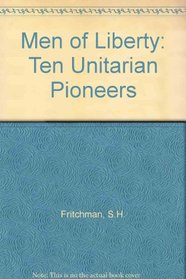Search -
Men of Liberty: Ten Unitarian Pioneers
Men of Liberty Ten Unitarian Pioneers
Author:
Men of Liberty TEN UNITARIAN PIONEERS By STEPHEN HOLE FRITCHMAN With Illustrations by HENDRIK WILLEM VAN LOON BOSTON The Beacon Press 1944 By STEPHEN H. FRITCHMAN People in the Liberal Church Copyright, 1944 THE AMERICAN UNITARIAN ASSOCIATION Second Printing July, 1944 3PJUNTEX m THE WETTED STATES OF Copyright in Canada U THE WORLD BELONGS TO TH... more »
Author:
Men of Liberty TEN UNITARIAN PIONEERS By STEPHEN HOLE FRITCHMAN With Illustrations by HENDRIK WILLEM VAN LOON BOSTON The Beacon Press 1944 By STEPHEN H. FRITCHMAN People in the Liberal Church Copyright, 1944 THE AMERICAN UNITARIAN ASSOCIATION Second Printing July, 1944 3PJUNTEX m THE WETTED STATES OF Copyright in Canada U THE WORLD BELONGS TO TH... more »
ISBN-13: 9780804601580
ISBN-10: 0804601585
Pages: 192
Edition: New impression
Rating: ?
ISBN-10: 0804601585
Pages: 192
Edition: New impression
Rating: ?
0 stars, based on 0 rating
Genres:




